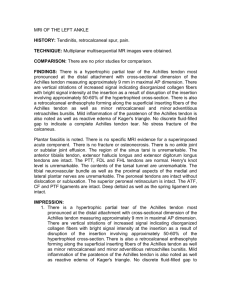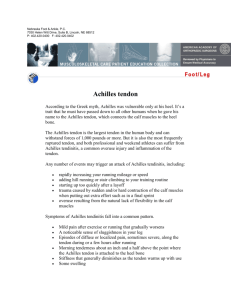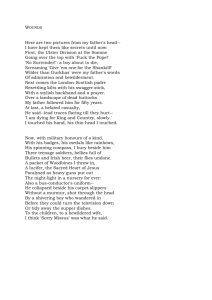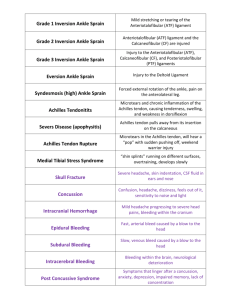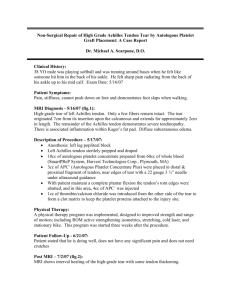Haglund deformity
advertisement
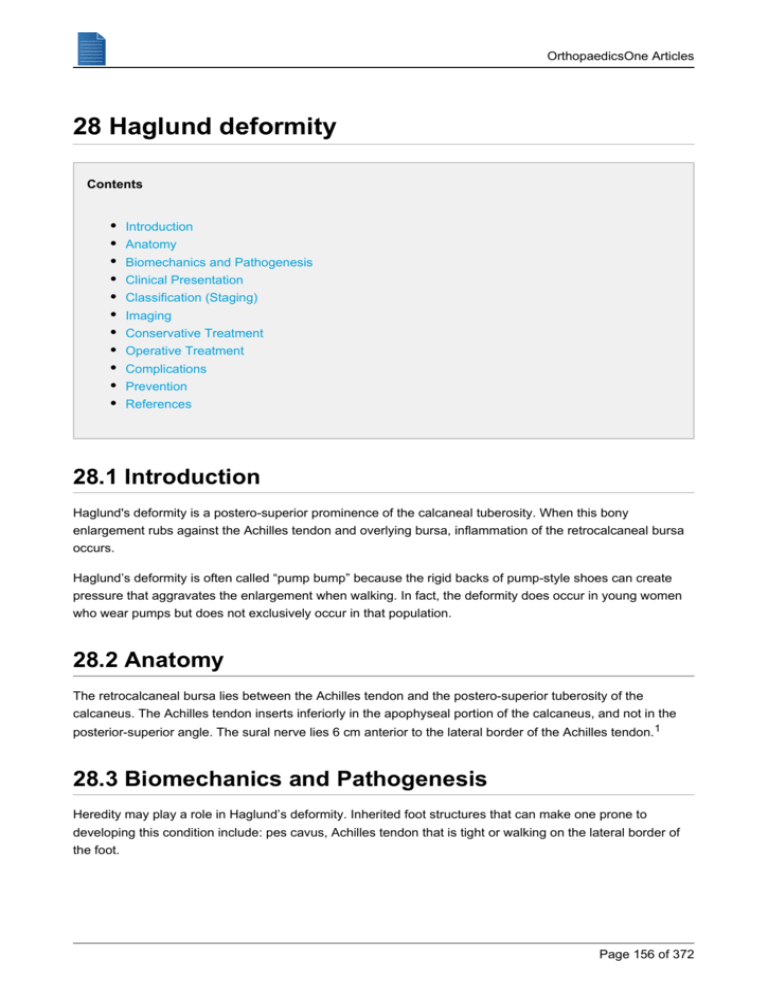
OrthopaedicsOne Articles 28 Haglund deformity Contents Introduction Anatomy Biomechanics and Pathogenesis Clinical Presentation Classification (Staging) Imaging Conservative Treatment Operative Treatment Complications Prevention References 28.1 Introduction Haglund's deformity is a postero-superior prominence of the calcaneal tuberosity. When this bony enlargement rubs against the Achilles tendon and overlying bursa, inflammation of the retrocalcaneal bursa occurs. Haglund’s deformity is often called “pump bump” because the rigid backs of pump-style shoes can create pressure that aggravates the enlargement when walking. In fact, the deformity does occur in young women who wear pumps but does not exclusively occur in that population. 28.2 Anatomy The retrocalcaneal bursa lies between the Achilles tendon and the postero-superior tuberosity of the calcaneus. The Achilles tendon inserts inferiorly in the apophyseal portion of the calcaneus, and not in the posterior-superior angle. The sural nerve lies 6 cm anterior to the lateral border of the Achilles tendon. 1 28.3 Biomechanics and Pathogenesis Heredity may play a role in Haglund’s deformity. Inherited foot structures that can make one prone to developing this condition include: pes cavus, Achilles tendon that is tight or walking on the lateral border of the foot. Page 156 of 372 OrthopaedicsOne Articles Pes cavus can contributes to Haglund’s deformity due to the attachment of the Achilles tendon. In people with pes cavus, the calcaneus is tilted backward into the Achilles tendon. This causes the uppermost portion of the back of the heel bone to rub against the tendon. Eventually, due to this constant irritation, the bursa becomes inflamed. It is the inflamed bursa that produces the redness and swelling associated with Haglund’s deformity. A tight Achilles tendon (such as in people with an equinus deformity or contracture) is thought to play a role in Haglund’s deformity, by causing pain by compressing the tender and inflamed bursa. In contrast, a tendon that is more flexible results in less pressure against the painful bursa. Another possible contributor to Haglund’s deformity is a tendency to walk on the lateral border of the foot. This tendency, which produces wear on the outer edge of the sole of the shoe, causes the heel to rotate inward, resulting in pressure of the heel bone against the tendon. The tendon protects itself by forming a bursa, which eventually becomes inflamed and tender. 28.4 Clinical Presentation Haglund’s deformity can occur in one or both feet. These patients often have noticeable swelling around the insertion of the Achilles tendon and just proximal to it (eg, part of the "pump bump," presumably named in association with the wearing of high-heeled shoes or pumps). Pain, and possibly redness, are reported around the insertion of the Achilles tendon. Patients who are accustomed to wearing high-heeled shoes on a long-term basis may experience increased stretch and irritation of the Achilles tendon and its associated bursae when switching to flat shoes. Symptoms often worsen when the person first initiates an activity after a period of rest. Tenderness caused by isolated subtendinous bursitis can best be isolated by palpation just anterior to both the medial and lateral edge of the distal Achilles tendon. Tenderness due to insertional Achilles tendinitis is located slightly more distal, where the Achilles tendon inserts onto the posterior calcaneus. 28.5 Classification (Staging) There is no classification scheme for Haglund’s deformity 28.6 Imaging Plain radiographs of the calcaneus may reveal a Haglund deformity (increased prominence of the posterosuperior aspect of the calcaneus). There are measurements for prominence of the posterior superior calcaneus, but they have limited clinical use. However, on weight-bearing lateral radiographs, the retrocalcaneal recess often appears normal even in patients with retrocalcaneal bursitis, limiting its usefulness in making this diagnosis. Page 157 of 372 OrthopaedicsOne Articles Plain radiographs can also be used to evaluate for stress fracture of the calcaneus. If the studies are negative for a stress fracture, but a stress fracture remains a significant diagnostic consideration, the clinician may wish to pursue 3-phase bone scanning, magnetic resonance imaging (MRI), or computed tomography (CT) scanning of the calcaneus. A stress fracture causes tenderness broadly over the lateral and medial posterior calcaneus while bursitis and tendectomy tenderness is over the bursa and achilles tendons. MRI may demonstrate bursal inflammation and show whether there are degenerative areas within the tendon (tendinosis). Ultrasonography may be a potentially useful tool for diagnosing pathologies of the Achilles tendon. 28.7 Conservative Treatment Non-surgical treatment of Haglund’s deformity is aimed at reducing the inflammation of the bursa. While these approaches can resolve the bursitis, they will not shrink the bony protrusion. Non-surgical treatment can include one or more of the following: Medication. Anti-inflammatory medications may help reduce the pain and inflammation. Topical anti-inflammatories can be helpful. Ice. To reduce swelling, apply a bag of ice over a thin towel to the affected area for 20 minutes of each waking hour. Do not put ice directly against the skin. Stretching exercises. Stretching can help relieve tension from the Achilles tendon in those patients with a tight heel cord. Heel lift. Patients with high arches may find that heel lifts placed inside the shoe decrease the pressure on the heel. Heel pads. Placing pads inside the shoe cushions the heel and may help reduce irritation when walking. Shoe modification. Wearing shoes that are backless or have soft backs will avoid or minimize irritation. Physical therapy. Inflammation is sometimes reduced with certain forms of physical therapy, such as ultrasound therapy. Orthotic devices. These custom arch supports are helpful because they control the motion in the foot. They can include a heel lift. Immobilization. In some cases, casting may be necessary to reduce symptoms. Cortisone injections in this area are not recommended due to the risk of tendon rupture. 28.8 Operative Treatment If non-surgical treatment fails to provide adequate pain relief, surgery may be needed. The foot and ankle surgeon will determine the procedure that is best suited to your case. It is important to follow the surgeon’s instructions for post-surgical care. Excision of the Haglund prominence can be effective in chronic cases: Page 158 of 372 OrthopaedicsOne Articles Lateral approach can be performed but the sural nerve is at risk. A medial incision or direct posterior incision could also be used. The Achilles tendon is dissected subperiosteally at the insertion of Achilles tendon (about 50% or less of the tendon is elevated) and the calcaneal prominence is removed. If present, calcium deposits are removed from the Achilles tendon. The posterior calcaneal tuberosity is removed, and the Achilles tendon is debrided and reattached using bone/suture anchors. Patients are immobilized for 4 to 6 weeks 28.9 Complications Achilles tendon laceration or avulsion Persistent posterior heel pain Wound breakdown Medial calcaneal sensory nerve injury Sural nerve injury Ankle stiffness Insicional neuroma^3^ 28.10 Prevention Recurrence of the deformity may be prevented by: Wearing appropriate shoes and avoiding shoes with a rigid heel back Using arch supports or orthotic devices. especially if they include heel lift and result in less pressure of the heel on the back of the shoes Performing stretching exercises to prevent the Achilles tendon from tightening Avoiding running on hard surfaces and running uphill. 28.11 References 1. Heneghan HO, CORR 1984;187:228 ??? 2. van Sterkenburg MN, Muller B, Maas M, Sierevelt IN, van Dijk CN. Appearance of the weight- bearing lateral radiograph in retrocalcaneal bursitis. Acta Orthop. Jun 2010;81(3):387-90. 3. Clain MR, Baxter DE: Achilles tendinitis. Foot Ankle 1992;13:482-487 4. Ly JQ, Bui-Mansfield LT. Anatomy of and abnormalities associated with Kager's fat Pad. AJR Am J Roentgenol. Jan 2004;182(1):147-54. 5. Blankstein A, Cohen I, Diamant L, et al. Achilles tendon pain and related pathologies: diagnosis by ultrasonography. Isr Med Assoc J. Aug 2001;3(8):575-8. 6. Reiter M, Ulreich N, Dirisamer A, Tscholakoff D, Bucek RA. Extended field-of-view sonography in Achilles tendon disease: a comparison with MR imaging. Rofo. May 2004;176(5):704-8. 7. Operative management of Haglund's deformity in the non athlete: a retrospective study. GJ Sammarco MD et al. FAI. Vol 19. No 11. Nov. 1998. p 724. Page 159 of 372 OrthopaedicsOne Articles 8. Chronic retrocalcaneal bursitis treated by resection of the calcaneus. P. Angermann. Foot and Ankle. Vol 10. 1990. p 285-287. 9. Prominence of the calcaneus: late results of bone resection. Huber, HM. JBJS. 74-B. 1992. p 315-316. 10. The Achilles tendon insertion is crescent-shaped: an in vitro anatomic investigation. Lohrer H et al, Clin Orthop Relat Res 2008 Sept 477(9): 2230-7 11. Surgery for retrocalcaneal bursitis: tendon splitting versus lateral approach, Anderson JA et al, Clin Orthop Relat Res 2008 July: 466(7): 1678-82 Page 160 of 372

